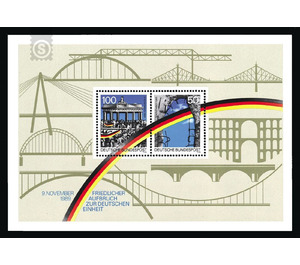Block edition: 1st anniversary of the opening of the inner-German borders and the Berlin Wall - Germany / Federal Republic of Germany 1990
Theme: Architecture
| Country | Germany / Federal Republic of Germany |
| Issue Date | 1990 |
| Item Type | Block |
| Chronological Chapter | GER-BRD |
| Chronological Issue Number | Block 22 |
| SID | 231227 |
| In 58 Wishlists | |
On November 9, 1989, the government of the GDR, still governed by the SED, opened the Berlin Wall and numerous crossings at the inner-German border. Worldwide, the wall, erected after 13 August 1961, was considered a particularly repulsive symbol of the unnatural division of Germany. She also stood for the division of Europe into a free and a non-free section. Over 190 Germans were killed at the inhuman border that cut across Germany and Europe for decades. The people of Germany suffered from the separation. Wall and barbed wire literally stood in their way. They wanted to come together because they belonged together. Even after decades of state division, the consciousness of the unity of the nation remained alive. As late as January 1989, the then SED Secretary General Honecker said that the wall would still stand in 100 years. Ten months later, her end had come. The people of the GDR, whom the SED regime so fondly referred to, had exercised their right to self-determination in a peaceful revolution and, with great courage and exemplary prudence, had won respect for human rights - starting with the fundamental right to free movement. "We are the people!" - with this call a revolution began, the course and results of which are unprecedented in recent German history. A dictatorship based on violence, harassment and spying was peacefully overcome. For the people in the GDR, the opening of the border meant the first step towards the re-establishment of Germany's unity: the call "We are the people!" Soon added the call "We are a people!". Since then, the desire for freedom and unity has set the pace of development. Almost eleven months after the fall of the Berlin Wall, German state unity was completed. The history of 9 November 1989 includes the flight of many people from the GDR to the embassies of the Federal Republic of Germany in Budapest, Prague and Warsaw. The Hungarian government was the first to allow these refugees to leave the country. This was like the first stone from the wall beaten. A development was set in motion that led, with irresistible consistency, to the unity of Germany in freedom. In 1989, the Leipzig demonstration on 9th October, the opening of the Berlin Wall and the German-German border on 9th November were announced by Federal Chancellor Helmut Kohl on 28th November to the German Bundestag »Ten-Point Program for Overcoming the Division of Germany and Germany Europe's "and the symbolic opening of the Brandenburg Gate just before Christmas important stops on this path. In 1990, the first free elections to the People's Chamber and the formation of a freely elected government of the GDR followed. With the agreement of a monetary, economic and social union on 1 July 1990, the course was set for the establishment of a social market economy in the GDR. In talks with President Mikhail Gorbachev, Federal Chancellor Kohl was able to clear the last obstacles to a successful conclusion of the "two-plus-four" talks on the external aspects of German unity. Finally, the decision of the People's Chamber of 23 August to join the Federal Republic of Germany in accordance with Article 23 of the Basic Law with effect from 3 October was the decisive step towards completing the unification of Germany and thus the prerequisite for the first all-German elections created the war on 2 December 1990.


